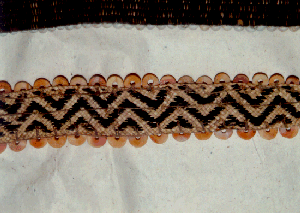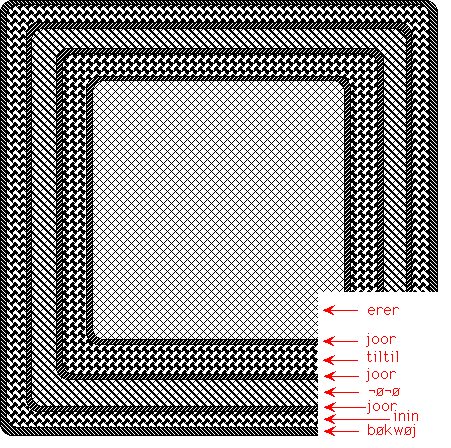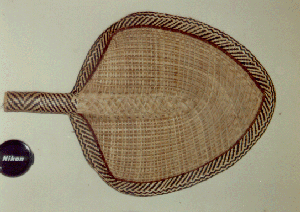

|
Essays on the Marshallese Past
Marshallese Dress |
It has been stated before by several observers that in the Marshall Islands tattoos and dress formed integral and inseperable parts of the overall attire. The mutual exclusiveness of tattooed areas on the body and the areas covered by pieces of clothing has been observed in cultures all over the world. In this section we will look at the traditional Marshallese dress. The tattoos will be discussed elsewhere in this book.
In the Marshall Islands, men's traditional dress seems partially to have
survived until the late 19th century, while women were wearing a
small cotton or calico dress over their mats, which had been relegated to
underwear.
Clothing
Traditional Marshallese dress for both sexes left the upper body unclothed and
covered only the lower body and the thighs.
Men's Dress
Traditionally, mens' dress consisted of clothing mats which would last for about one year in constant use. Two types of wear could be distinguished.Lagebˆ , where one corner of the mat is pulled between the legs to the front and tucked into the belt. The other three corners are tucked into the belt at the back and the sides, covering the back of the thighs but not their fronts. This type of wear was used for daily work and fishing but considered inappropriate indoors in the presence of chiefs. The other way to wear a mat was kal ortuman , whereby the mat was worn in an apron-like fashion, wound around the body. Chiefs on festive occasions would wear a grass skirt covered by a mat hanging over at the front.
Traditional grass skirts (in), worn by men, were two clusters of fibres which were fastened together by a band. The skirt, made from the bark of the weed Triumphetta procumbens (atat), or from the bark of the Hibicus bush (lo), did not go round the body in a continous fashion, but left both outer sides of the thighs free. The skirt had a longer part in the front, reaching to the level of the knees. The men did not wear any other clothing.
Thus the male tattooing, which covered front and back, as well as the sides
of the thighs, combined with the grass skirt itself, gave the man the
appearance of a fully dressed individual. Rarely, mainly on festive occasions,
higher ranking or older chiefs would wear two mats wrapped around the legs
and their torso but this dress was already on the demise at the time of the
misionaries.
Women's Dress
Adult women wore two mats, one covering the front and a second one put on the back with both sides coming round to the front, partially over the front mat. The mats were held in place by a belt (kangurngur) which could be as long as fifty metres according to ethnographers of the time. Both mats of a pair were commonly made with the same motif pattern. Chiefly women would wear a third mat to protect the-good-clothing mats, espcially when sitting down on the ground.
In traditional times a woman's dress changed the moment she became [visibly] pregnant. She began wearing different mats and thereby signalled the new standing in society.
Young girls wore a small mat around their lower body area. The men's type of mat wear, lagebˆ, was used by girls only during erotic ceremonial dances.

Marshallese clothing mats collected in the 1880s on Jaluit (Knappe Collection; Photographs Courtesy Museum f‘r Th‘ringer Volkskunde, Erfurt)

Marshallese clothing mats collected in the 1880s on Jaluit (Knappe Collection; Photographs Courtesy Museum f‘r Th‘ringer Volkskunde, Erfurt)
The Marshallese took particular pride, it seems with the belts. A simple belt (kangur), about a handwidth's wide, was wrapped around the waist and held with a string of coconut fibre. The belt is then covered by theidik , a belt string which is made from white and black (dyed) Pandanus leaves tightly and spirally wrapped around a coconut fibre core. Thekangur is made of 20-25 Pandanus leaves, which have been sown together end to end with a considerable overlap.

Marshallese belts (kangur) in the Knappe Collection. (Photographs Courtesy Museum f‘r Th‘ringer Volkskunde, Erfurt)
Men and women wore the hair long. Men wore the hair combed back and tied up
into a tight knot high above their head (bujek). This customary
way of wearing one's hair was also adopted by a number of early Europeans
living in the Marshall Islands, such as the two survivors of the mutiny of the
whaleship Globe (1821), Cyrus Lay and William Hussey. Women's hair was also
worn in knot, but the knot was placed at the neck (bujek).
Children carried their hair hanging down.
Ornaments
The ornaments worn by the Marshallese encompass armrings made of sections cut from Conus and Trochus shells, armbands made from small shellbeads, arm and head ornaments made from feathers of seabirds, pendants made from shells, turtle shell and whale and porpoise teeth, as well as necklaces made from shells, coconut shells, and seeds.
The chiefs also wore flat woven belts on which a number of shell plates and
beads was mounted. In addition to these "permanent" ornaments
necklaces, leis, and headbands, as well as arm and earlobe ornaments, existed
which were woven from flowers and leaves.
Other
Marshallese girls also used to paint their finger nails red, using the dye from a Murex shell. The enlargement of the earlobes (ralil) was very common among men. The earlobes were pieced with a sharks tooth and gradually enlarged by insertion of leaves. In order to achieve larger holes, some people had parts of their cheeks cut so that the enlargement could reach as far down as the mandible. The enlarged earlobe was also used as a temporary receptacle to carry clay pipes, tobacco sticks, pencils, and the like. In extreme cases the earlobe could be extended to such an extent that it could be pulled over the head.


Top: Marshallese pendants and necklaces. Bottom: a woven bag to contain precious goods (Alele) Both collected in the 1880s on Jaluit (Knappe Collection; photographs Courtesy Museum f‘r Th‘ringer Volkskunde, Erfurt)

Symbolic structure of a Nieded (clothing mat).
Pandanus leaves forms the major source of raw materials for mat weaving. The leaves are cut from the tree and the ends as well as the thorns are cut off. When dried each individual leaf is softened by rolling it back and forth in to circular shape and pressing it down with the hands until it is pliable. It the leaf is still stiff, it can be pounded soft with the dekenin, a pounder made from the giant clam shell. The leaves for sitting mats are less well pounded than the leaves used to weave clothing mats. When sufficiently soft, the leaves are cut into the strips of the desired width. The strips used for clothing mats are the narrowest, often less than an eight of an inch, while the strips used for siting mats are much wider.
The picture above shows a
In addition to mats, Marshallese wove baskets with a sliding lid, to keep valuables (Alele), as well as fans.

A Marshallese fan, collected in the 1880s on Jaluit. (Knappe Collection; photograph Courtesy Museum f‘r Th‘ringer Volkskunde, Erfurt)
| select from the following... | ||||||
| |
||||||
|
Digital Micronesia-An
Electronic
Library & Archive
is provided free of charge
as an advertising-free
information service
for the world community. It is being maintained by Dirk
HR Spennemann, Associate
Professor in Cultural
Heritage Management, Institute of Land, Water and Society and School
of Environmental & Information Sciences, Charles
Sturt University,
Albury, Australia. The server
space and technical support are provided by Charles
Sturt University as part of its commitment
to regional engagement. Environmental
SciencesInformation
Sciences
|
||||||